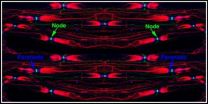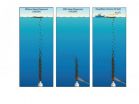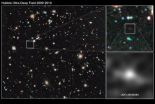(Press-News.org) CHAPEL HILL, N.C. -- New research from the University of North Carolina at Chapel Hill School of Medicine describes a key molecular mechanism in nerve fibers that ensures the rapid conductance of nervous system impulses. The findings appear online Jan. 27, 2011 in the journal Neuron.
Our hard-wired nerve fibers or axons rely on an insulating membrane sheath, the myelin, made up of fatty white matter to accelerate the rate of transmission of electrical impulses from the brain to other parts of the body.
Myelin thus acts to prevent electrical current from leaking or prematurely leaving the axon. However, the myelin surrounding the axon isn't continuous; there are regularly spaced unmyelinated gaps about 1 micrometer wide along the axon. These unmyelinated regions named as nodes of Ranvier are where electrical impulses hop from one node to the next along the axon, at rates as fast as 160 meters per second (360 mph).
Determining exactly how the nodes of Ranvier function and how they are assembled, has fired the interest of neuroscientists for more than a century," said UNC neuroscientist Manzoor Bhat, PhD, Professor of Cell and Molecular Physiology in the UNC Neuroscience Research Center. "The answers may also provide important clues to the development of targeted treatments for multiple sclerosis and other disorders involving demyelination and/or disorganization of nodes of Ranvier."
Bhat and colleagues focused on a protein called Neurofascin 186, which accumulates in the membranes of axons at the nodes of Ranvier. Together with proteins Ankyrin-G and sodium channels, these molecules form a complex that facilitates passage of sodium ions through the channels in axons, thus making them paramount for the propagation of nerve impulses along myelinated nerve fibers.
Bhat's team had previously identified a homolog of Neurofascin in laboratory studies of Drosophila nerve fibers, and because its in vivo function had not been clearly defined in a mammalian system, they decided to study the function of this protein in laboratory mice.
Using targeted gene deletion methods, the UNC scientists genetically engineered mice lacking Neurofascin 186 in their neurons. "This caused the failure of sodium channels and Ankyrin-G to accumulate at the nodes of Ranvier. The result was paralysis, as there was no nerve impulse conductance," Bhat said.
According to Bhat, Neurofascin is an adhesion molecule that serves as the nodal organizer. "Its job is to cluster at the nodes of Ranvier. In doing so, it brings together sodium channels and Ankyrin-G where they interact to form the nodal complex. And if you don't have this protein, the node is compromised and there is no impulse propagation along the axon."
In further analysis, the researchers identified another important function of the nodes of Ranvier in myelinated nerve cells: to act as barriers to prevent the invasion of the nodal gap by neighboring paranodal molecular complexes. "So this tells us that sodium channels, Neurofascin 186, and Ankyrin-G must always remain in the node to have functional organization. If they don't, the flanking paranodes will move in and occupy the nodal gap and block nerve conduction," Bhat said.
The UNC neuroscientists see clinical implications for human disease. "In MS, for example, the proteins that make up the nodal complex start diffusing out from their normal location once you start losing the myelin sheath. If we can restore the nodal complex in nerve fibers, we may be able to restore some nerve conduction and function in affected axons." Their future studies are aimed at understanding whether the nodal complex could be reorganized and nerve conduction restored in genetically modified mutant mice.
"The discovery of an essential gap protein is exciting because it opens up the possibility that tweaking the protein could restore normal gap function in people with multiple sclerosis and other diseases in which the myelin sheaths and gaps deteriorate over time," said Laurie Tompkins, PhD, who oversees Manzoor Bhat's and other neurogenetics grants at the National Institutes of Health.
INFORMATION:
Support for the research came from the National Institute of General Medical Sciences, the National Institute of Neurological Disorders & Stroke of the National Institutes of Health and the National Multiple Sclerosis Society.
UNC co-authors are postdoctoral fellow Courtney Thaxton, PhD; research specialist, Anilkumar Pillai; and graduate student, Alaine Pribisco. Dr. Jeffrey Dupree, assistant professor at Virginia Commonwealth University, collaborated in these studies.
Membrane molecule keeps nerve impulses hopping
2011-01-27
ELSE PRESS RELEASES FROM THIS DATE:
Discovery of a biochemical basis for broccoli's cancer-fighting ability
2011-01-27
Scientists are reporting discovery of a potential biochemical basis for the apparent cancer-fighting ability of broccoli and its veggie cousins. They found for the first time that certain substances in the vegetables appear to target and block a defective gene associated with cancer. Their report, which could lead to new strategies for preventing and treating cancer, appears in ACS' Journal of Medicinal Chemistry.
Fung-Lung Chung and colleagues showed in previous experiments that substances called isothiocyanates (or ITCs) — found in broccoli, cauliflower, watercress, ...
First report on fate of underwater dispersants in Deepwater Horizon oil spill
2011-01-27
Scientists are reporting that key chemical components of the 770,000 gallons of oil dispersants applied below the ocean surface in the Deepwater Horizon spill did mix with oil and gas spewing out of the damaged wellhead and remained in the deep ocean for two months or more without degrading. However, it was not possible to determine if the first deep ocean use of oil dispersants worked as planned in breaking up and dissipating the oil. Their study, the first peer-reviewed research published on the fate of oil dispersants added to underwater ocean environments, appears in ...
Getting more anti-cancer medicine into the blood
2011-01-27
Scientists are reporting successful application of the technology used in home devices to clean jewelry, dentures, and other items to make anticancer drugs like tamoxifen and paclitaxel dissolve more easily in body fluids, so they can better fight the disease. The process, described in ACS' journal, Langmuir, can make other poorly soluble materials more soluble, and has potential for improving the performance of dyes, paints, rust-proofing agents and other products.
In the report, Yuri M. Lvov and colleagues point out that many drugs, including some of the most powerful ...
Fish smile but some consumers frown at new genre of phosphate-free detergents
2011-01-27
Phosphate-free automatic dishwashing detergents — introduced to combat the phosphate-fed algae blooms that foul the nation's lakes and rivers — may be making the fish happy. But they're putting a frown on the faces of some consumers who say the new products leave dishes dirty. That's the topic of the cover story in the current edition of Chemical & Engineering News (C&EN), ACS' weekly newsmagazine.
C&EN Assistant Managing Editor Michael McCoy described how new laws in 16 states require manufacturers to eliminate phosphates from automatic dishwasher detergents sold in ...
Hubble finds a new contender for galaxy distance record
2011-01-27
Astronomers have pushed the NASA/ESA Hubble Space Telescope to its limits by finding what is plausibly the most distant and ancient object in the Universe [1] ever seen. Its light has travelled for 13.2 billion years to reach Hubble [2], which corresponds to a redshift around 10. The age of the Universe is 13.7 billion years.
The dim object, called UDFj-39546284, is likely to be a compact galaxy of blue stars that existed 480 million years after the Big Bang, only four percent of the Universe's current age. It is tiny. Over one hundred such mini-galaxies would be needed ...
Shockable cardiac arrests are more common in public than home
2011-01-27
Cardiac arrests that can be treated by electric stimulation, also known as shockable arrests, were found at a higher frequency in public settings than in the home, according to a National Institutes of Health-funded study appearing in the Jan. 27 issue of the New England Journal of Medicine.
The study compared home and public cardiac arrests under various scenarios. For example, the study considered whether bystanders or emergency medical services (EMS) personnel witnessed the cardiac arrest, and whether the person experiencing the arrest received treatment with an automatic ...
Hubble sees farther back in time than ever before
2011-01-27
Pasadena, CA— Astronomers have pushed NASA's Hubble Space Telescope to it limits by finding what they believe to be the most distant object ever seen in the universe—at a distance of 13.2 billion light years, some 3% of the age of universe. This places the object roughly 150 million light years more distant than the previous record holder. The observations provide the best insights yet into the birth of the first stars and galaxies and the evolution of the universe. The research is published in the 27th January edition of Nature.
The dim object is a compact galaxy made ...
NASA's Aqua Satellite sees Tropical Depression Anthony heading toward Australia
2011-01-27
NASA's Aqua Satellite captured a visible image of the former Tropical Storm Anthony, now weakened to a tropical depression, but forecasters aren't counting Anthony out yet. Despite its weakened condition Anthony continues to move west toward Queensland, Australia and into a more favorable area for sustaining a tropical cyclone.
The Atmospheric Infrared Sounder (AIRS) instrument that flies aboard NASA's Aqua satellite captured a visible image on Jan. 26 at 03:23 UTC of Tropical Depression Anthony in the South Pacific Ocean. The image revealed a cloud-filled center of the ...
NASA's TRMM Satellite sees TD10S strengthen into Tropical Storm Bianca
2011-01-27
The life of a cyclone is a complex one, and NASA satellites have kept track of a low that has now become Tropical Storm Bianca just off the northern coast of Western Australia.
What began as a low pressure system designated as System 98S on January 24, brought rains near Kuri Bay, Australia. On January 25, System 98S strengthened into the tenth tropical depression of the Southern Pacific Ocean hurricane season and was designated as "10S." Today, January 26, that low intensified into a tropical storm and was named Bianca.
NASA's Tropical Rainfall Measuring Mission (TRMM) ...
Gender and hygiene: Could cleanliness be hurting girls?
2011-01-27
CORVALLIS, Ore. – Little girls growing up in western society are expected to be neat and tidy – "all ribbon and curls" – and one researcher who studies science and gender differences thinks that emphasis may contribute to higher rates of certain diseases in adult women.
The link between increased hygiene and sanitation and higher rates of asthma, allergies and autoimmune disorders is known as the "hygiene hypothesis" and the link is well-documented. Yet the role of gender is rarely explored as part of this phenomenon.
Oregon State University philosopher Sharyn Clough ...





